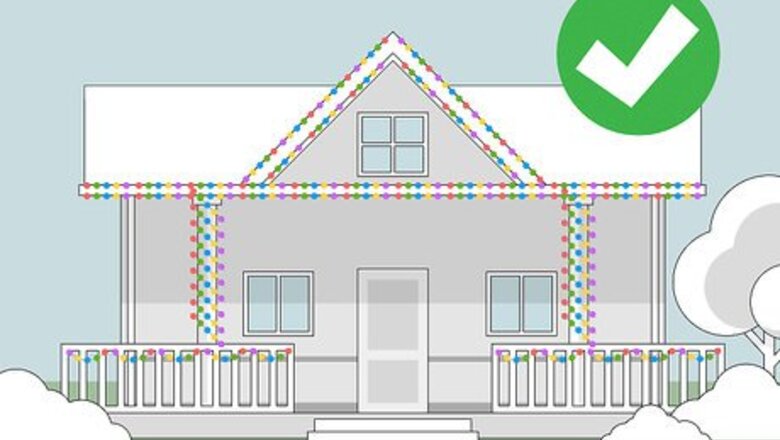
views
Choose a Suitable Lighting Display
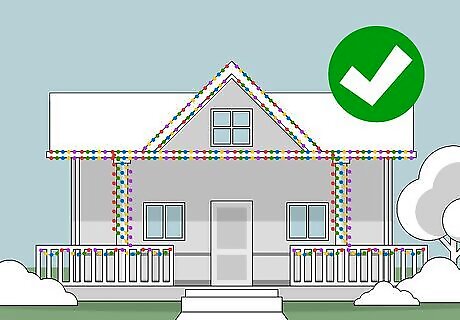
Align the Christmas lighting display with the style of your home. Is your home a modern house, a Tudor, or a Victorian? Is a basic tract house or multi-storey? A lighting display should complement both the style of the house and the style of the neighborhood without spoiling it or looking garish. Some considerations to bear in mind: For a Victorian style house, there may well be no such thing as “over the top". But elegance is a key factor. Strings, strings and more strings of lights around every architectural feature of the house will enhance its stature, making your home the neighborhood beacon of holiday cheer. A ranch-style or single story home calls for lights around the roof line, the fence and along your entrance walkway. Multi-storey homes call for the same basic theory as a Victorian, with less “fluff". String lights along the roof line, around columns, along the porch railing.

Get some inspiration. If you're short on ideas, do a search on Google, or browse through a few magazines for ideas that may be suitable for your own use.

Walk around your neighborhood. Borrow ideas that catch your fancy, but avoid copying another house exactly. That won't look good for either house. If you're new to the neighborhood, visit with your neighbors and find out what people generally do for holiday lighting. You may discover that your street is the street to visit during Christmas, and that everybody goes overboard on lighting.

Check out home furnishing stores. Especially the high-end ones. You’ll find excellent ideas for dressing up your windows inside. This treatment becomes part of the view from the outside.
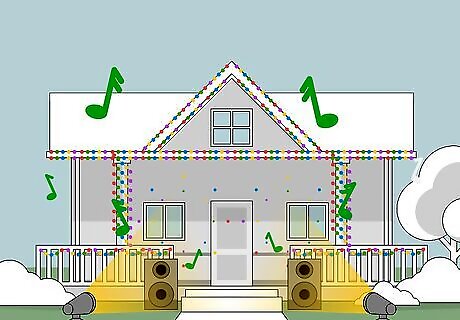
Go crazy! If you're really after an eye-grabbing lighting display, consider hooking up a control system to make your Christmas lights flash to music.
Preparing the Lighting and Display Areas

Examine the lights before you get started. Make certain that they all work and that there are no frayed areas in the cords before you take them up the ladder. Avoid repairing frayed cords. Dispose of the entire string if you find damaged cords—it is not worth the risk of fire or electrocution.
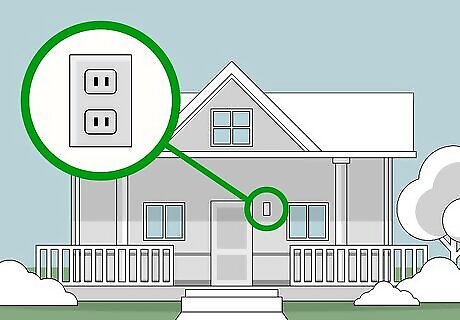
Locate the power sources nearest the roof line. It will probably be on the porch, as most houses do not have a power outlet receptacle near the roof. You’re going to need at least one good extension cord. Select an exterior cord which is compatible with your lights, and with the weather it will endure. If you have a porch light that's shielded from the elements, you may be able to insert a socket adapter that places a power socket between the fixture and the lamp. Running an extension cord through a hole or a window or door is a fire hazard and a code violation in most places. You will need to find an outdoor power outlet or else use battery-powered lights. If you have an exterior outlet somewhere on the house, install your extension cord from the outlet to the roof line keeping the cord as close to the building as possible. Be sure the outlet is protected from rain, snow and sprinklers. It should have a hood that protects it from getting wet even while the lights are plugged in. Under the national electrical code in the USA (and most of Central America), all outdoor receptacles installed after enactment of the 1971 edition were required to be protected with a ground-fault circuit interrupter (GFCI). If the outlet you are using doesn't have that, you may want to have someone install one now, or you may plug in a portable or cord-mounted GFCI device for temporary use. Local code requirements may be more strict.
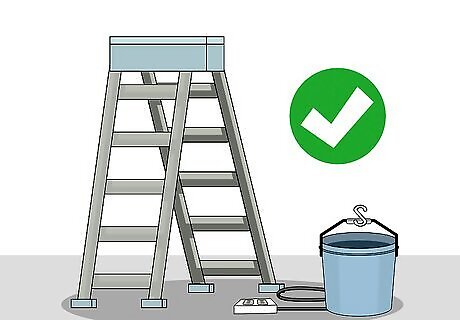
Use the right tools. Use a reliable, sturdy ladder, and get a helper if you can. Outdoor lighting requires a lot of lifting, careful placement and aligning, which is much easier to do with a helper (or two). If you work alone, use a basket or bucket with a handle to haul your materials up and down. Put a nail or an S hook on the ladder so you can hang your tote bucket. Limit the number of times you go up and down the ladder, but do not lean to reach anything. When you can’t reach the next position, move the ladder. Do one step of the project to its completion before you begin the next phase.
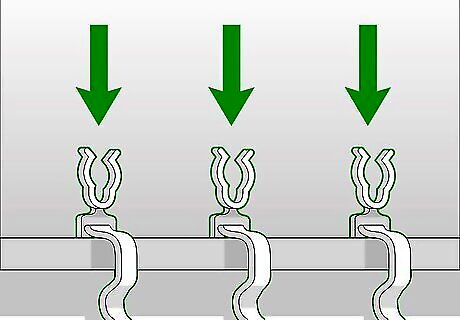
Install fasteners. Pre-installed hooks or holders over which to drape the extension cord(s) and the light strings will make it much easier to hang your lights. Space the fasteners uniformly with the distance of area between the bulbs on the light strings. (Finish this step completely before you start hanging the lights). Note! While nails, screws and other metallic fasteners seem an easy answer, they are conductors of electricity, they rust, and they put holes into your structure. There are many products on the market made of rubber or heavy duty plastic designed for hanging electrical cords. Consult the sales staff at a reputable hardware store. Tell them what you will be doing with them. They’re fairly inexpensive and easy to install. Look for fasteners with a moisture resistant, peel-and-stick backing that will hold up to ten pounds.
Put Up the Lighting
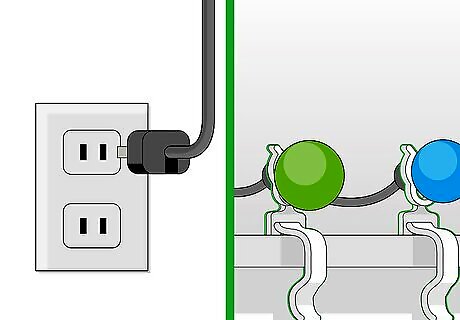
Hang the lights. Start at the power source and follow the fasteners to the end of the project. Hang one string, then plug in the next string, end-to-end. Don’t cut corners by plugging all the strings together. Don't connect more than three sets together, or you risk overloads and chances for fire. Be certain that the light string cords are secure in or on the fastener. You don’t want wind, birds, small animals, or Santa to knock them off!
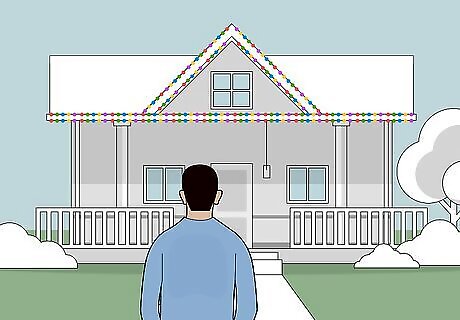
Check out your work. Get down to the ground, turn on the lights and stand back away from the house. Check for uniformity. Get a second pair of eyes from a family member or a neighbor. Good job!
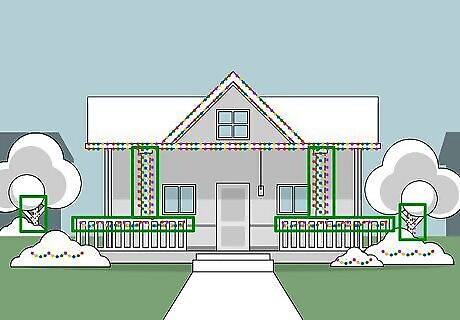
After completing the roof line, decorate the other elements of your home. Columns: Combining the light strings with holiday garland (natural or artificial) will enable you to wrap a column (barber pole style) with ease. The additional bulk of a garland will help avoid slippage of the light strings and add a little pizazz, too! If you need a little adhesion, space and hide small pieces of removable tacky clay behind the string garland. Removable tacky clay is available at reputable craft or hardware stores. Porch Railing: Open baluster style: Using the same barber pole technique with garland, loop the light strings over and under the railing. Secure it as needed with removable tacky clay. Porch Railing: Along the top of the porch enclosure (one that is like a ½ wall) use the rubber or plastic, peel and stick fasteners that were used along the roof line. Note: these fasteners may be ineffective on concrete or stucco. Windows: Place around, over and under windows in such a way as to frame the windows. Fences: Use the same techniques as on the porch railings. Trees: There are a variety of solutions for trees. Either use the traditional wrap as you do with indoor trees, or use a net of lights that drape over the top of the tree. You can also use single strands connected to a heavy-duty extension cord with multiple taps, and trace the branches of your trees with white or colored lights. Use plastic-coated twist ties to secure the lighting to the limbs.
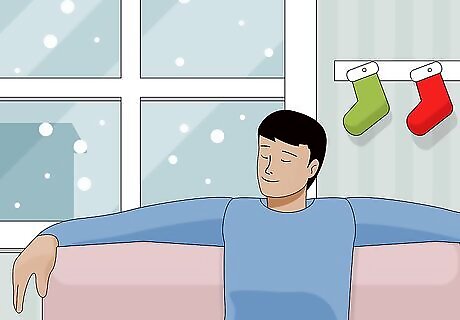
Sit back and enjoy the holidays!















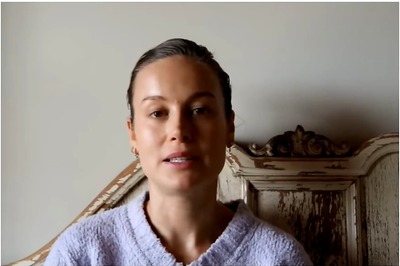


Comments
0 comment